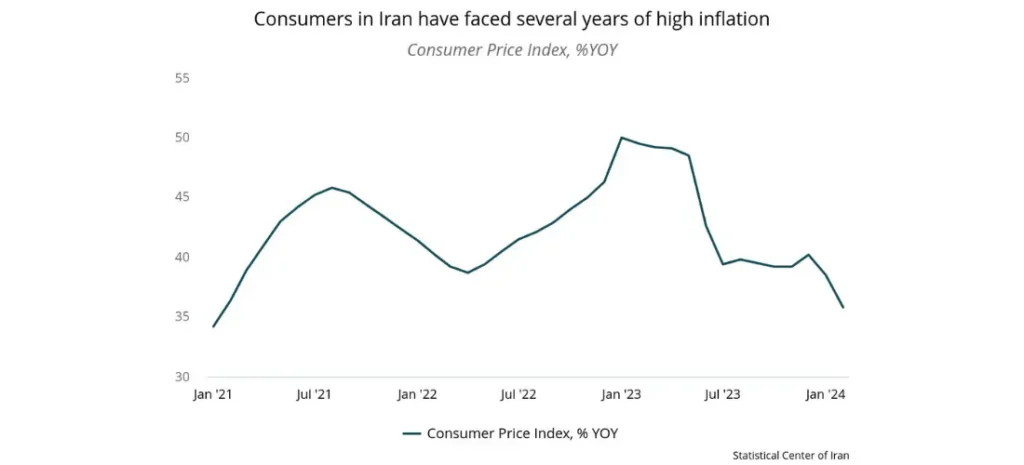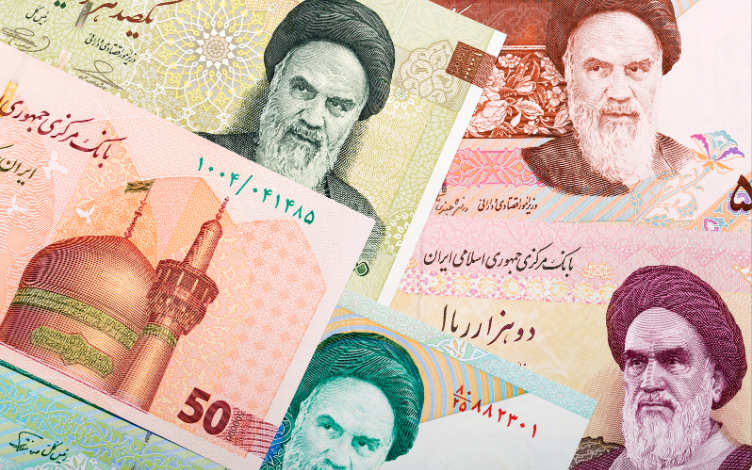
The rial has depreciated significantly in recent weeks
Iran held elections in early March, which saw conservatives secure the bulk of seats for both parliament and the Assembly of Experts- tasked with supervising the supreme leader’s performance and appointing his successor.
This insight bite assesses Iran’s consumer outlook in 2024. It is part of a series of insight bites assessing Iran’s 2024 outlook following the March elections, and will be followed by one on Iran’s political outlook and one on public spending.
Business Implications
Several years of high inflation have eroded purchasing power in Iran, with over 80% of consumers’ spending now allocated to necessities. Multinationals can expect to see aggressive trading down among most consumer segments. Consumer confidence will remain extremely low due to years of subsequent price increases and a depreciating currency. The absence of nuclear negotiations in 2024 means economic sanctions will continue to dampen Iran’s growth outlook for the foreseeable future. Consequently, Iran will be ruled out as a viable market in 2024.
Details
GDP
GDP grew by 6.7% YOY in the first nine months of the Iranian fiscal year (March 21 to December 20, 2023). An increase in oil production and exports drove growth in the oil sector – which grew 21.8% YOY in Q4 2023. Other notable sectors that saw growth include services, which grew 4.6% YOY in Q4 2023. The agriculture and energy (gas, electricity, and power) sectors contracted by -1%YOY and -5.6% YOY respectively. FrontierView expects GDP to average ~1.9% YOY in 2024. Steady oil exports and increases in production will be supporting growth, while the non-oil economy (notably sectors such as agriculture) will be lagging average GDP in 2024.
Inflation
Inflation eased from 38.5%YOY in January to 35.8% in February, with food inflation decreasing from 38.9% YOY to 31.6% YOY. Despite this, prices of essential goods- such as cooking oil and soap- have continued to increase. Studies have shown that red meat in Iran is more expensive than in any other country in the MENA region. Alongside this, there is a high likelihood that fuel subsidies will be cut during the next Iranian year (which is set to begin on March 19th 2024) . FrontierView expects inflation to average 30% YOY in 2024, after 45% in 2023.
Currency
The Iranian rial has depreciated sharply against the US dollar since the start of the year. At the time of writing, the rial’s parallel market rate stands at around IRR 600,000to the dollar, depreciating more than 20% since the start of the year. Government officials attributed the rial’s fall to rising tensions in the region. The NIMA *rate continues to trade at IRR 285,000 to the dollar. FrontierView expects the black market rate to fluctuate between 500,000 and 600,000 to the dollar for the next 3 months, and the NIMA rate to hold at around IRR 285,000 to the dollar in 2024-albiet with potential for slight depreciation to ~ 300,000 to the dollar.
Our View
Elevated money supply growth, coupled with a weak parallel market FX rate and continuation of economic sanctions will keep inflation elevated and risk further fluctuations in the rial’s market rate. Alongside this, the rial will continue to depreciate in the absence of regional de-escalation efforts amidst the war in Gaza. The removal of fuel subsidies- while necessary to curb runaway energy consumption- will further fuel inflation and weigh on severely dampened consumer spending.
The risk of civil unrest remains high amidst further austerity measures and low political satisfaction with the government (voter turnout dropped to 41% in the March elections). FrontierView does not expect stricter sanctions enforcement on Iranian oil in 2024- but attempts at informal nuclear negotiations will be put on hold for the foreseeable future. Growth in headline GDP is not reflective of living conditions amongst Iranian citizens. While economic growth will be sustained with the relaxed enforcement of sanctions on Iranian oil, living standards will remain low in 2024 as consumers continue to face high inflation and eroded purchasing power.
*NIMA rate is fixed by the government and used for exports and imports. Notably, most multinationals operating in Iran use this rate.
At FrontierView, our mission is to help our clients grow and win in their most important markets. We are excited to share that FiscalNote, a leading technology provider of global policy and market intelligence has acquired FrontierView. We will continue to cover issues and topics driving growth in your business, while fully leveraging FiscalNote’s portfolio within the global risk, ESG, and geopolitical advisory product suite.
Subscribe to our weekly newsletter The Lens published by our Global Economics and Scenarios team which highlights high-impact developments and trends for business professionals. For full access to our offerings, start your free trial today and download our complimentary mobile app, available on iOS and Android.

